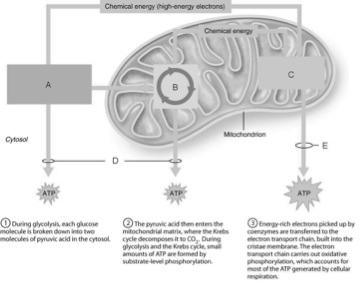
Ten-step enzymatically driven process that converts glucose into pyruvic acid
A
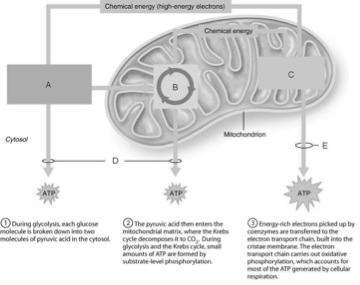
Occurs via substrate-level phosphorylation.
D
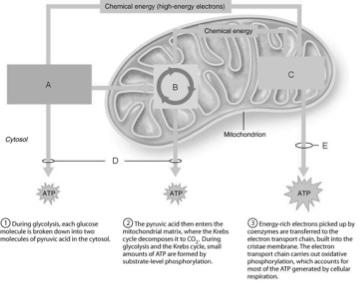
Produces the CO2 involved during glucose oxidation
B
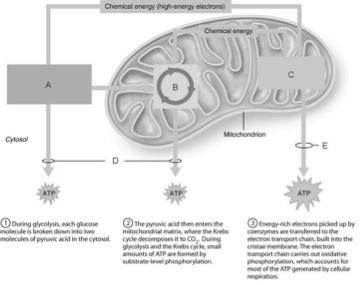
Where the hydrogens removed during the oxidation of food fuels are combined with O2.
C
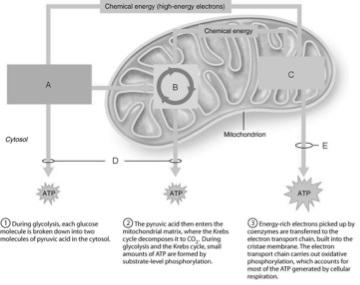
Contains ATP synthases, small rotary motors
C
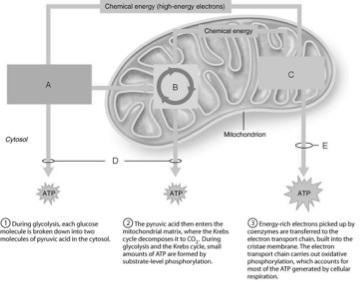
ATP formed by oxidative phosphorylation.
E
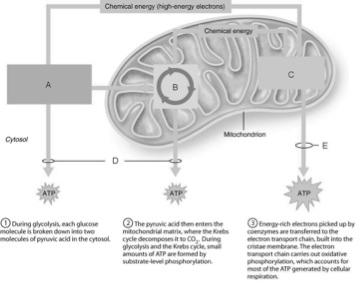
Involves sugar activation, sugar cleavage, and oxidation and ATP formation.
A
Glucose serves as the initial reactant.
A) Glycolysis
B) Oxidation reaction
C) Krebs cycle and electron transport chain.
A
Involves the removal of hydrogen electrons and CO2 from the substrate molecule
A) Glycolysis
B) Oxidation reaction
C) Krebs cycle and electron transport chain.
B
Occurs in the cytosol of a cell.
A) Glycolysis
B) Oxidation reaction
C) Krebs cycle and electron transport chain.
A
Produces the most ATP
A) Glycolysis
B) Oxidation reaction
C) Krebs cycle and electron transport chain.
C
Involves the use of oxygen to pick up excess hydrogen and electrons.
A) Glycolysis
B) Oxidation reaction
C) Krebs cycle and electron transport chain.
B
Breakdown of glycogen to release glucose.
A) glycogenesis
B) glycogenolysis
C) glycolysis
D) gluconeogenesis
B
Formation of glucose from proteins or fats.
A) glycogenesis
B) glycogenolysis
C) glycolysis
D) gluconeogenesis
D
Storage of glucose in the form of glycogen
A) glycogenesis
B) glycogenolysis
C) glycolysis
D) gluconeogenesis
A
Breakdown of glucose to pyruvic acid.
A) glycogenesis
B) glycogenolysis
C) glycolysis
D) gluconeogenesis
C
Synthesis of lipids from glucose or amino acids.
A) lipolysis
B) beta oxidation
C) lipogenesis
D) ketogenesis
C
Splitting of triglycerides into glycerol and fatty acids.
A) lipolysis
B) beta oxidation
C) lipogenesis
D) ketogenesis
A
Conversion of fatty acids into acetyl groups.
A) lipolysis
B) beta oxidation
C) lipogenesis
D) ketogenesis
B
Formation of ketone bodies
A) lipolysis
B) beta oxidation
C) lipogenesis
D) ketogenesis
D
True/False Questions
Beta oxidation is the initial phase of fatty acid oxidation, and it occurs in the cytoplasm.
False
True/False Questions
The increased use of noncarbohydrate molecules for energy to conserve glucose is called glucose sparing
True
True/False Questions
Except for lactose and some glycogen, the carbohydrates we ingest are mainly from animals.
False
True/False Questions
The term essential nutrient refers to the chemicals that can be interconverted in the liver so that the body can maintain life and good health.
False
True/False Questions
The most abundant dietary lipids in the diets of most Americans are triglycerides.
True
True/False Questions
There are no complete proteins. All animal products should be eaten with plant material to make a complete protein.
False
True/False Questions
The body is considered to be in nitrogen balance when the amount of nitrogen ingested in lipids equals the amount excreted in urine.
False
True/False Questions
The amount of protein needed by each person is determined by the age, size, and metabolic rate of the person.
True
True/False Questions
Vitamins are inorganic compounds that are essential for growth and good health.
False
True/False Questions
Cellular respiration is an anabolic process
False
True/False Questions
Glycolysis is a series of six chemical steps, most of which take place in the mitochondria
False
True/False Questions
Glycogenesis begins when ATP levels are high, and glucose entering cells is phosphorylated to glucose-6-phosphate and converted to its isomer, glucose-1-phosphate.
True
True/False Questions
All athletes require diets high in protein and calories in order to perform and to maintain their muscle mass.
False
True/False Questions
In order for amino acids to be oxidized for energy, the amine group (NH2) must be removed.
True
True/False Questions
Including the ATP from glycolysis, the cell gains 34 ATP molecules from aerobic metabolism of one glucose molecule.
False
True/False Questions
The body requires adequate supplies of only three minerals (calcium, sodium, chloride) and trace amounts of all others.
False
True/False Questions
Processes that break down complex molecules into simpler ones are anabolic.
False
True/False Questions
For use as fuel, all food carbohydrates are eventually transformed to glucose.
True
True/False Questions
Triglycerides and cholesterol do not circulate freely in the bloodstream.
True
True/False Questions
Normal body temperature range is 98.6-100°F, regardless of external temperature.
False
True/False Questions
A deficit of potassium can cause rickets.
False
True/False Questions
It would not be healthy to eliminate all fats from your diet because they serve a useful purpose in maintaining the body.
True
True/False Questions
The body's thermoregulatory centers are located in the thalamus.
False
True/False Questions
Carbohydrate and fat pools are oxidized directly to produce cellular energy, but amino acid pools must first be converted to a carbohydrate intermediate before being sent through cellular respiration pathways.
True
True/False Questions
High levels of HDLs are considered good
True
True/False Questions
Diets high in cholesterol and saturated fats tend to produce high HDL concentrations.
False
True/False Questions
Ghrelin, produced by the stomach, is a powerful appetite stimulant.
True
True/False Questions
Peptides called NPY and AgRP are powerful appetite enhancers.
True
True/False Questions
The primary function of carbohydrates is energy production within cells.
True
The molecule that serves as the major source of readily available fuel for neurons and blood cells is ________.
A) fat
B) glucose
C) acetyl CoA
D) cellulose
B) glucose
Which of the choices below is not a fate of carbohydrate taken into the body?
A) ATP production
B) lipogenesis
C) amino acid synthesis
D) conversion to a nucleic acid
E) glycogenesis
D) conversion to a nucleic acid
Dietary fats are important because they ________.
A) keep blood pressure normal
B) help the body absorb fat-soluble vitamins
C) contribute significantly to the health of the skin
D) help prevent the common cold
B) help the body absorb fat-soluble vitamins
Cholesterol, though it is not an energy molecule, has importance in the body because it ________.
A) is a stabilizing component of the plasma membranes and is the parent molecule of steroid hormones
B) helps provide essential nutrients to the brain and lungs
C) helps mobilize fats during periods of starvation
D) enters the glycolytic pathway without being altered
A) is a stabilizing component of the plasma membranes and is the parent molecule of steroid hormones
Which of the following statements best describes complete protein?
A) derived from meat and fish only
B) meets all the minimum daily requirements for a healthy diet
C) derived only from legumes and other plant material
D) must meet all the body's amino acid requirements for maintenance and growth
D) must meet all the body's amino acid requirements for maintenance and growth
The term metabolism is best defined as ________.
A) the length of time it takes to digest and absorb fats
B) a measure of carbohydrate utilization, typically involving measurement of calories
C) the number of calories it takes to keep from shivering on a cold day
D) biochemical reactions involved in building cell molecules or breaking down molecules for energy
D) biochemical reactions involved in building cell molecules or breaking down molecules for energy
The term metabolic rate reflects the ________.
A) energy the body needs to perform only its most essential activities
B) loss of organic molecules in urine
C) energy needed to make all organic molecules
D) loss of energy to perspiration
A) energy the body needs to perform only its most essential activities
When proteins undergo deamination, the waste substance found in the urine is mostly________.
A) urea
B) ammonia
C) acetyl CoA
D) ketone bodies
A) urea
It is important to ensure that your diet is adequately rich in vitamins because ________.
A) vitamins provide protection against the common cold
B) very few foods contain vitamins
C) most vitamins are coenzymes needed to help the body utilize essential nutrients
D) all vitamins are water soluble and pass out of the body too quickly to ensure utilization
C) most vitamins are coenzymes needed to help the body utilize essential nutrients
Oxidation-reduction reactions are catalyzed by which of the following enzymes?
A) dehydrogenases and oxidases
B) kinases and phosphorylases
C) phosphatases and kinases
D) synthetases and lipases
A) dehydrogenases and oxidases
Which of the choices below describes the pathway of cellular respiration (the complete oxidation of glucose)?
A) glycolysis, Krebs cycle, electron transport chain, oxidative phosphorylation
B) gluconeogenesis, Krebs cycle, lipolysis
C) lipolysis, glycogenolysis, beta oxidation
D) glycogenesis, lipogenesis, electron transport chain
A) glycolysis, Krebs cycle, electron transport chain, oxidative phosphorylation
Anabolism includes reactions in which ________.
A) carbohydrate utilization increases
B) larger molecules or structures are built from smaller ones
C) structural proteins are used as a potential energy source
D) ketone bodies are formed
B) larger molecules or structures are built from smaller ones
Catabolism would be best described as a process that ________.
A) causes a decline in circulating ketone bodies
B) builds up triglycerides during the postabsorptive state
C) breaks down complex structures to simpler ones
D) elevates glucagon levels
C) breaks down complex structures to simpler ones
The primary function of cellular respiration is to ________.
A) determine the amount of heat needed by the human body
B) provide the body with adequate amounts of vitamins and minerals
C) efficiently monitor the energy needs of the body
D) break down food molecules and generate ATP
D) break down food molecules and generate ATP
The process of breaking triglycerides down into glycerol and fatty acids is known as ________.
A) gluconeogenesis
B) fat utilization
C) lipogenesis
D) lipolysis
D) lipolysis
Which of the following mechanisms produces the most ATP during cellular respiration?
A) oxidative phosphorylation
B) substrate-level phosphorylation
C) oxidation-reduction reactions
D) oxidation reactions
A) oxidative phosphorylation
Lipogenesis occurs when ________.
A) there is a shortage of fatty acids
B) glucose levels drop slightly
C) excess proteins are transported through the cell membrane
D) cellular ATP and glucose levels are high
D) cellular ATP and glucose levels are high
Oxidative deamination takes place in the ________.
A) liver
B) muscles
C) kidneys
D) blood
A) liver
Transamination is the process whereby the amine group of an amino acid is ________.
A) transferred to acetyl CoA
B) converted to urea
C) transferred to a keto acid
D) converted to ammonia
C) transferred to a keto acid
Glycogen is formed in the liver during the ________.
A) postabsorptive state
B) absorptive state
C) starvation period
D) period when the metabolic rate is lowest
B) absorptive state
Which of the following is a normal consequence of the activation of the heat-promoting center?
A) release of epinephrine
B) sympathetic sweat gland activation
C) increase in ADH production
D) vasodilation of cutaneous blood vessels
A) release of epinephrine
Gluconeogenesis is the process in which ________.
A) glycogen is broken down to release glucose
B) glucose is formed from noncarbohydrate precursors
C) glycogen is formed
D) glucose is converted into carbon dioxide and water
B) glucose is formed from noncarbohydrate precursors
Glycolysis is best defined as a catabolic reaction based upon the ________.
A) conversion of glucose into carbon dioxide and water
B) conversion of glucose into two molecules of pyruvic acid
C) conversion of pyruvic acid into carbon dioxide and water
D) formation of sugar
B) conversion of glucose into two molecules of pyruvic acid
What is the outcome of ketosis?
A) water retention and edema
B) metabolic acidosis
C) metabolic alkalosis
D) glycogen buildup
E) glucogenesis
B) metabolic acidosis
Which of the choices below happens during the absorptive state?
A) Anabolic processes exceed catabolic ones.
B) Catabolic processes exceed anabolic ones.
C) No metabolism occurs.
D) Only glucose metabolism occurs.
A) Anabolic processes exceed catabolic ones.
In the case of a person who consumes a normal, balanced diet, proteins are essential to the body for all of the following except ________.
A) production of energy
B) production of some hormones
C) production of enzymes, clotting factors, and antibodies
D) formation of functional molecules like hemoglobin and cytochromes
A) production of energy
The most abundant dietary lipids are ________.
A) cholesterol
B) phospholipids
C) fatty acids
D) triglycerides
D) triglycerides
Loss of heat in the form of infrared waves is termed ________.
A) radiation
B) convection
C) conduction
D) evaporation
A) radiation
Which hormone directs essentially all the events of the absorptive state?
A) growth hormone
B) thyroid hormone
C) epinephrine
D) insulin
D) insulin
Prostaglandins play a role in ________.
A) skeletal muscle contraction
B) control of blood volume
C) noninflammatory responses
D) control of blood pressure
D) control of blood pressure
Which of the following is the most important function of the liver?
A) carbohydrate and lipid metabolism
B) synthesis of bile salts
C) processing of drugs and hormones and activation of vitamin D
D) protein metabolism
D) protein metabolism
As the body progresses from the absorptive to the postabsorptive state, only the ________ continues to burn glucose while every other organ in the body mostly switches to fatty acids.
A) liver
B) brain
C) pancreas
D) spleen
B) brain
In gluconeogenesis, during the postabsorptive state, amino acids and ________ are converted to glucose.
A) glycerol
B) glycogen
C) glyceraldehyde
D) glucagon
A) glycerol
In the liver, the amine group of glutamic acid is removed as ________ in the oxidative state.
A) glyceraldehyde
B) pyruvic acid
C) ammonia
D) oxaloacetic acid
Answer: C
C) ammonia
Which of the choices below is not a mechanism of heat production?
A) vasoconstriction of cutaneous blood vessels
B) shivering
C) sweating
D) enhanced thyroxine release
C) sweating
Heat-loss mechanisms do not include ________.
A) reducing activity
B) the evaporation of sweat
C) behavior measures such as wearing light, loose clothing
D) vasoconstriction of peripheral blood vessels
D) vasoconstriction of peripheral blood vessels
The amount of ________ produced is probably the most important hormonal factor in determining BMR.
A) norepinephrine
B) thyroxine
C) prolactin
D) ADH
B) thyroxine
When ketone bodies are present in the blood and urine in large amounts, it usually indicates increased metabolism of ________.
A) amino acids
B) fatty acids
C) glycogen
D) lactic acid
B) fatty acids
Many factors influence BMR. What is the most critical factor?
A) the way an individual metabolizes fat
B) the way skeletal muscles break down glycogen
C) the ratio of surface area to volume (weight) of the body
D) an individual's body weight
C) the ratio of surface area to volume (weight) of the body
The primary reason elderly people should decrease their caloric intake is that ________.
A) muscle mass and metabolism decline with age
B) their appetite begins to diminish
C) they have a higher metabolic rate and do not need large amounts of food
D) they spend most of the day at rest, and their food will quickly turn to fat
A) muscle mass and metabolism decline with age
Which of the choices below is not a major route of heat exchange?
A) radiation
B) conduction/convection
C) evaporation
D) shivering
D) shivering
Which of the following statements is a false or incorrect statement?
A) The amino acid pool is the body’s total supply of amino acids in the body’s proteins.
B) Fats and carbohydrates are oxidized directly to produce cellular energy.
C) Amino acids can be used to supply energy only after being converted to a carbohydrate intermediate.
D) Excess carbohydrate and fat can be stored as such, whereas excess amino acids are oxidized for energy or converted to fat or glycogen for storage.
A) The amino acid pool is the body’s total supply of amino acids in the body’s proteins.
Which of the following molecules are considered key molecules at metabolic crossroads?
A) glucose-6-phosphate, pyruvic acid, acetyl CoA
B) glucose-6-phosphate, lactic acid, acetyl CoA
C) acetone, beta-hydroxybutyric acid, ATP
D) ATP, pyruvic acid, lactic acid
A) glucose-6-phosphate, pyruvic acid, acetyl CoA
Which of the following nutrients yield the highest amount of energy per gram when metabolized?
A) fats
B) vitamins and minerals
C) foods and beverages high in caffeine
D) proteins
A) fats
Which of the following does not occur in the mitochondria?
A) electron transport
B) glycolysis
C) Krebs cycle
D) formation of malic acid from fumaric acid
B) glycolysis
Which of the following is not true of beta oxidation?
A) It occurs in the mitochondrion.
B) Every second carbon is reduced.
C) It involves the anabolism of fats.
D) Fatty acids are broken into acetic acid fragments.
C) It involves the anabolism of fats.
Select the correct statement about proteins.
A) Strict vegetarians need not worry about adequate protein intake, as most vegetables are almost perfect sources of amino acids.
B) Proteins can be synthesized in the body if most of the amino acids are present.
C) Proteins will be used by most cells for ATP synthesis if insufficient carbohydrates are ingested.
D) Catabolic steroids (hormones) accelerate the rate of protein synthesis.
C) Proteins will be used by most cells for ATP synthesis if insufficient carbohydrates are ingested.
Oxidation reduction reactions ________.
A) utilize hydrogenases
B) may involve the loss of hydrogen and electrons
C) are rarely coupled together
D) occur via the gain of hydrogen or the loss of oxygen
B) may involve the loss of hydrogen and electrons
What process primes a molecule to change in a way that increases its activity, produces motion, or does work?
A) phosphorylation
B) beta oxidation
C) cellular respiration
D) glycolysis
A) phosphorylation
Which of the choices below is not a source of glucose during the postabsorptive state?
A) glycogenolysis in the liver
B) lipolysis in adipose tissues and the liver
C) absorption of glucose from the GI tract
D) catabolism of cellular protein
C) absorption of glucose from the GI tract
Which of the following is correct?
A) Most of the ATP are produced by substrate-level phosphorylation.
B) Oxidation of FADH2 eventually yields four ATP via oxidative phosphorylation.
C) Glycolysis relies on substrate-level oxidation for the four ATP produced in this pathway.
D) Most ATP from cellular respiration are produced directly in the Krebs cycle.
B) Oxidation of FADH2 eventually yields four ATP via oxidative phosphorylation.
Which of the following food groups are considered good sources of complete proteins?
A) corn, cottonseed oil, soy oil, and wheat germ
B) lima beans, kidney beans, nuts, and cereals
C) egg yolk, fish roe, and grains
D) eggs, milk, yogurt, meat, and fish
D) eggs, milk, yogurt, meat, and fish
Conditions that promote the oxidative deamination and energy use of amino acids include ________.
A) adequate essential amino acids
B) adequate fat calories to provide adequate ATP formation
C) excessive amounts of protein in the diet
D) ammonia combining with oxygen to form urea
C) excessive amounts of protein in the diet
When a person's hypothalamic thermostat is set to a higher level and the actual body temperature is below that level, the person may ________.
A) pant
B) exhibit vasodilation of skin vessels
C) perspire heavily
D) shiver
D) shiver
Glucose can be obtained from ________.
A) glycogenolysis
B) triglyceride anabolism
C) protein anabolism
D) lipogenesis
A) glycogenolysis
Which of the following is not a function of LDLs?
A) transport cholesterol from the peripheral tissues to the liver
B) regulate cholesterol synthesis in tissue cells
C) make cholesterol available to tissue cells for membrane or hormone synthesis
D) influence cholesterol synthesis in tissue cells
A) transport cholesterol from the peripheral tissues to the liver
Which of the following best defines negative nitrogen balance?
A) Protein breakdown exceeds protein synthesis.
B) It is a condition usually caused by having a diet low in fish and meat.
C) A negative nitrogen balance is normal and is a way of maintaining homeostasis.
D) It occurs when amino acids are broken down by liver enzymes and carried to the bloodstream.
A) Protein breakdown exceeds protein synthesis.
The Krebs cycle produces ________ ATP molecules per glucose molecule by substrate-level phosphorylation.
two
Which nutritional state constitutes the period during and shortly after eating when nutrients are flushing into the bloodstream from the GI tract?
absorptive
Fat burning causes an accumulation of acetyl CoA, which the liver converts to ________.
ketones
________ is controlled hyperthermia
Fever
The enzymes that catalyze oxidation-reduction reactions by removing hydrogen are specifically called ________.
dehydrogenases
The process of splitting glucose through a series of steps that produces two pyruvic acid molecules is called ________.
glycolysis
In the Krebs cycle, citric acid is followed by ________ acid.
isocitric